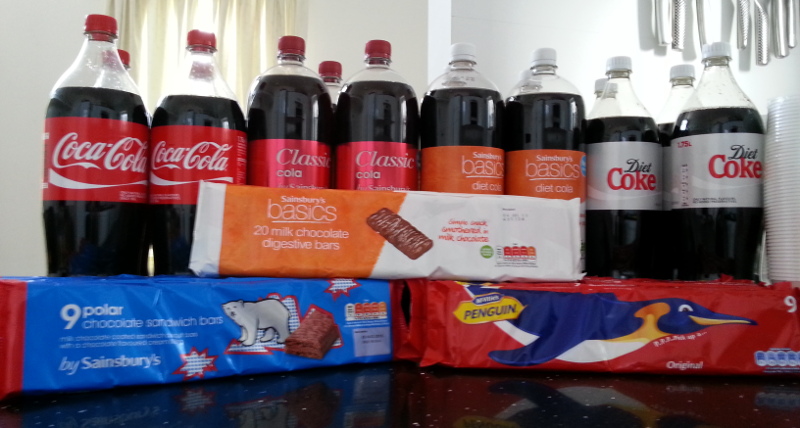Taste testing for fun and profit
Last week I ran three blind taste tests at a local meetup. They covered cola, diet cola, and chocolate sandwich bars. I wanted to find out what goes into running a taste test, how peoeple react and to get some measurable results.

My inspiration was a recent TV programme called “Eat Well for Less?” In the show families have their normal grocery replaced with substitutes in plain packaging - most of which are cheaper. If the family accept the substitutes the annual savings are revealed and they typically come to thousands of pounds.
My motivation is to explore the possbility of prompting people to save money on groceries, by encouraging them to blind taste test. Perhaps as a subscription service.
Results
Approximately 100 people (majority male) were present. Some people tried more than one category. 20 tried the cola, 12 tried diet cola, and 18 tried the chocolate. Cola and diet cola showed a preference for the branded products.
| Product | Preferred by |
|---|---|
| Coca Cola | 75% |
| Sainsburys Classic Cola | 25% |
| Product | Preferred by |
|---|---|
| Diet Coke | 70% |
| Sainsbury’s Basics Diet Cola | 30% |
Chocolate bars showed a small preference for the supermarket own products.
| Product | Preferred by |
|---|---|
| Penguin Bar | 25% |
| Sainsbury’s Basics Chocolate Digestive Bar | 35% |
| Sainsbury’s Polar Bar | 35% |
25% of tasters preferred Penguin bars, 35% preferred 40% preferred Sainsburys Polar Bars
Tasters were also asked how often they shop for groceries, and how much they spend per trip. Once multiplied to give annual spending the self reported numbers varied between £70 per person per year, and £9000 per person per year. Given the extremely wide range of numbers I did not analyse this further.
Conclusions
There may be a market for helping people to switch from branded products. The potential for substituion is likely to vary greatly across categories. Most tasters clerly preferred Coca Cola, but only a minority preferred Penguin bars. Self reported grocery spend is not a reliable measure. Suggesting people don’t realise how much they’re spending, and how much they could save.
Methodology and limitations
- The test lasted roughly 2 hours.
- Tests were only single blind. All packaging was removed and items were randomly assigned a three digit number. However I knew the products.
- Drinks were served in 150ml cups, people weren’t required to drink all of the contents - some took only a sip.
- Chocolate was served in half-bar portions. Most people ate the entire portion.
- Order of serving was not randomised.
- People were discouraged from discussing their preferences before completing the response form.
- Tasters weren’t provided a way to rinse their mouth between tastings.
- All colas were poured at the start of the test. They went flat within an hour of pouring, half way through the test.
- One of the chocolate bars was visually different from the other two. Whilst preparing them I discovered the Sainsbury’s Basics bars have a biscuit filling, rather than a sandwich filling.
Lessons learned
- Cola goes flat quickly. Pour it as needed, or switch to still drinks.
- Use smaller servings of drink to avoid waste and standardise the quantity consumed.
- Future tests will need better design to scale up to larger sample sizes, and to avoid biases such as Serial position effect
- Take more photos